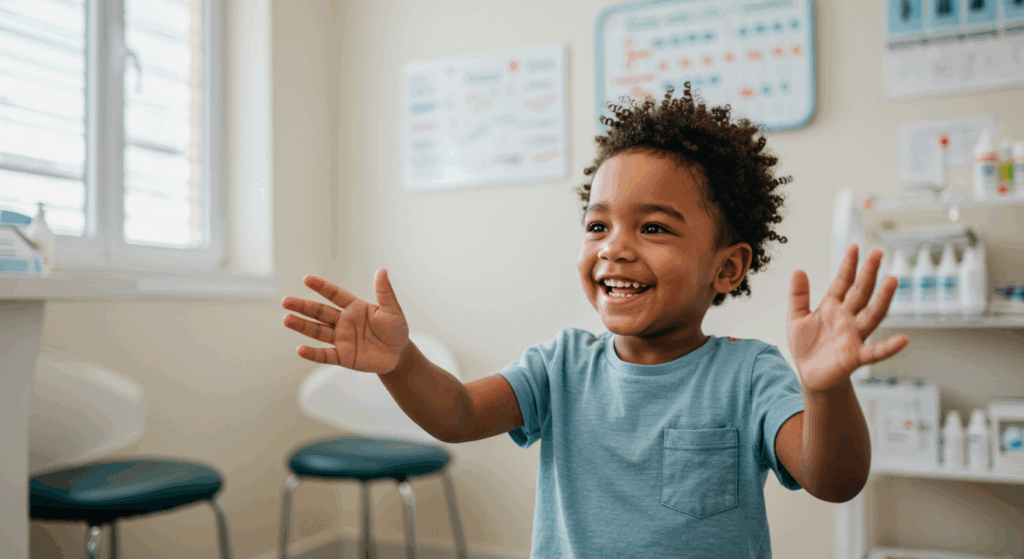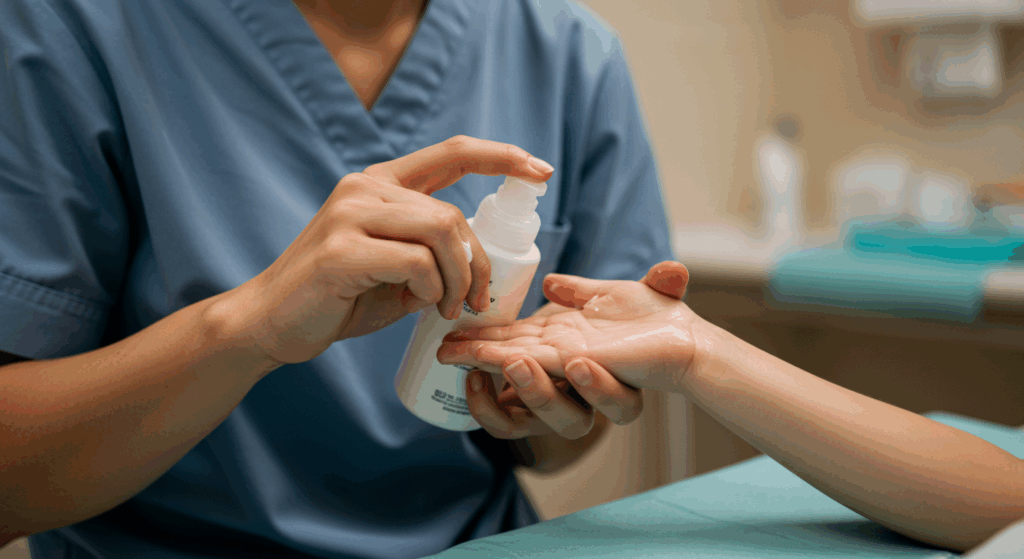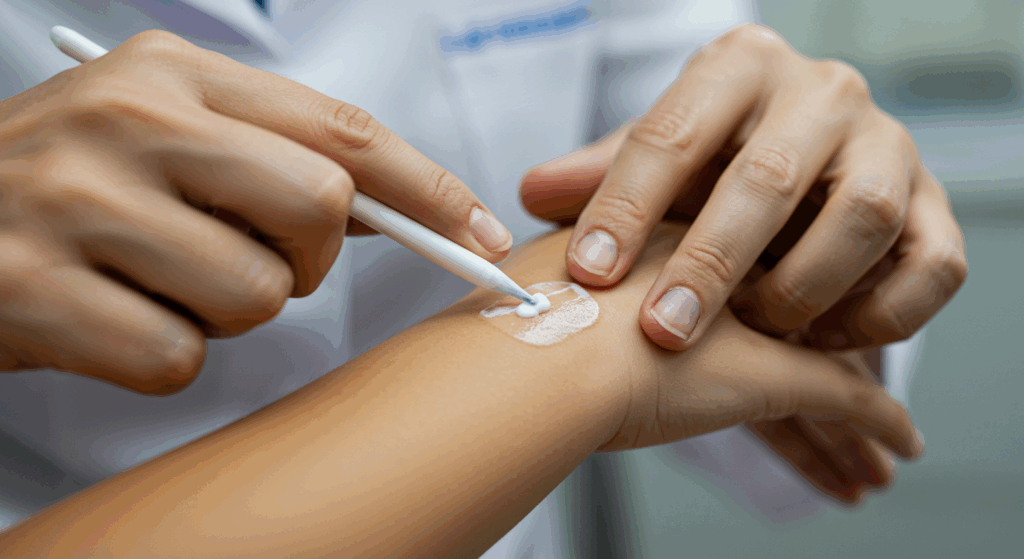As a parent, discovering a skin issue on your child can be alarming. From itchy rashes to stubborn eczema, pediatric skin conditions affect millions of children worldwide. At Dr. Ebru Okyay’s clinic in Antalya, we specialize in pediatric dermatology, ensuring safe and effective treatments tailored to young patients. In this comprehensive 2025 guide, we’ll explore proven protocols that prioritize safety, minimize side effects, and promote healthy skin development. Whether you’re dealing with atopic dermatitis or infectious outbreaks, you’ll gain actionable insights to navigate your child’s care confidently.
Pediatric dermatology focuses on diagnosing and treating skin disorders in children from infancy through adolescence. Unlike adult skin, children’s skin is more delicate, absorbent, and prone to rapid changes. Our approach at drebruokyay.com emphasizes evidence-based practices, gentle interventions, and holistic care to support long-term skin health. By the end of this article, you’ll understand how to identify common issues, follow safe treatment protocols, and when to seek professional help from experts like Dr. Okyay.

Understanding Pediatric Dermatology: Key Principles for Safe Care
Pediatric dermatology is a specialized field that addresses the unique vulnerabilities of children’s skin. Children’s skin barrier is thinner, making it more susceptible to irritants, allergens, and infections. In 2025, advancements in non-invasive diagnostics and personalized medicine have revolutionized how we approach these conditions. At our Antalya clinic, we integrate the latest guidelines from the American Academy of Dermatology and European pediatric societies to ensure treatments are both effective and safe.
The Importance of Age-Appropriate Treatments
Treatments must be customized based on a child’s age, as infants under 2 years cannot tolerate many adult formulations. For example, topical steroids in pediatric dermatology are selected with lower potency to avoid systemic absorption. We prioritize moisturizers, emollients, and barrier creams as first-line defenses. Studies show that consistent moisturizing can reduce flare-ups in eczema by up to 70%, making it a cornerstone of our protocols.
Additionally, genetic factors play a role; conditions like ichthyosis or epidermal nevi often require lifelong management starting early. Early intervention prevents complications such as secondary infections or scarring, which can impact self-esteem during formative years.
Diagnostic Approaches in Pediatric Dermatology
Diagnosis begins with a thorough history and physical exam. Non-invasive tools like dermoscopy and teledermatology allow for accurate assessments without distress to the child. In cases of suspected allergies, patch testing is adapted for sensitive skin. At drebruokyay.com, we use AI-assisted imaging for precise lesion analysis, reducing the need for biopsies in young patients.
| Diagnostic Tool | Purpose in Pediatrics | Safety Benefits |
|---|---|---|
| Dermoscopy | Examine moles and rashes closely | Non-invasive, no pain |
| Wood’s Lamp | Detect fungal or pigment disorders | Quick and harmless UV light |
| Patch Testing | Identify allergens | Modified for children to minimize irritation |
| Teledermatology | Remote consultations | Reduces clinic visits, less stress |
For more on chronic skin conditions that may affect children, explore our guide on Chronic Skin Conditions.

Common Pediatric Skin Conditions and Their Safe Treatment Protocols
Children encounter a variety of skin issues, from benign to chronic. Understanding these allows for prompt, safe intervention. In Antalya’s warm climate, conditions like heat rash and infections are prevalent, but our protocols ensure gentle management.
Atopic Dermatitis (Eczema): Gentle Skincare Routines
Eczema affects up to 20% of children, causing itchy, inflamed skin. Safe protocols start with avoiding triggers like harsh soaps or wool fabrics. Daily bathing with fragrance-free cleansers followed by thick moisturizers is essential. For flares, low-potency topical corticosteroids like hydrocortisone 1% are used sparingly.
In moderate cases, calcineurin inhibitors such as tacrolimus offer steroid-sparing options. Wet wrap therapy—applying medication under damp bandages—enhances absorption while soothing the skin. Probiotics and essential fatty acids may support gut-skin axis health, reducing severity per 2025 research.
- Daily Routine: Bathe in lukewarm water for 10 minutes, pat dry, apply moisturizer within 3 minutes.
- Flare Management: Use prescribed topicals; avoid scratching with mittens or distractions.
- Monitoring: Track symptoms in a journal to identify patterns.
Acne in Adolescents: Non-Scarred Approaches
Though often associated with teens, acne can start earlier. Benzoyl peroxide washes and topical retinoids like adapalene are safe starters. Oral antibiotics are reserved for inflammatory cases, with probiotics to mitigate gut issues. In 2025, light-based therapies like blue light are gaining traction for antibacterial effects without resistance.
Hormonal influences in girls may warrant spironolactone after puberty. Education on non-comedogenic products prevents worsening. Our clinic emphasizes psychological support, as acne impacts confidence.
| Condition | Safe First-Line Treatment | Duration | Precautions |
|---|---|---|---|
| Atopic Dermatitis | Emollients + Low-potency steroids | Indefinite maintenance | Avoid eyes, monitor for thinning |
| Acne Vulgaris | Topical benzoyl peroxide | 4-6 weeks initial | Sun protection, gradual introduction |
| Impetigo | Topical mupirocin | 5-7 days | Hand hygiene to prevent spread |
| Warts | Salicylic acid plasters | Up to 12 weeks | Not for facial warts in young kids |
Learn about common childhood skin problems in our detailed article: Common Childhood Skin Problems in Antalya.
Infectious Conditions: Antibacterial and Antifungal Protocols
Bacterial infections like impetigo require topical antibiotics to prevent scarring. Viral conditions such as molluscum contagiosum often resolve spontaneously, but cryotherapy or imiquimod can accelerate clearance safely. Fungal infections, common in humid Antalya, are treated with azoles like clotrimazole, avoiding oral antifungals unless systemic.
Prevention through hygiene education is key. For persistent cases, we reference guidelines from the Infectious Diseases Society of Pediatrics.
Birthmarks and Vascular Lesions: Watchful Waiting vs. Intervention
Many birthmarks fade naturally, but hemangiomas may need beta-blockers like propranolol if they ulcerate or obstruct. Laser therapy with pulsed dye lasers is safe post-infancy. Multidisciplinary care involving ophthalmology ensures no deeper involvement.
Evidence-Based Treatment Protocols: Ensuring Safety and Efficacy in 2025
Safe protocols in pediatric dermatology follow a stepwise approach: conservative measures first, escalating only as needed. In 2025, biologics like dupilumab for severe eczema mark a milestone, offering targeted relief without broad immunosuppression.
Topical Therapies: Selection and Application Guidelines
Topicals are the backbone of treatment. Occlusive dressings enhance efficacy but require monitoring for maceration. Vehicle selection—creams for dry skin, gels for oily—optimizes adherence. We advise fingertip units for dosing to prevent overuse.
For psoriasis in children, vitamin D analogs combined with corticosteroids provide synergy. Phototherapy is adapted with narrowband UVB, limiting sessions to avoid burns.
Systemic Treatments: When and How to Use Safely
Oral medications are judiciously used. Methotrexate for severe psoriasis requires folate supplementation and liver monitoring. Biologics necessitate screening for infections. At our clinic, we conduct baseline labs and educate on vaccination status.
| Systemic Agent | Indications | Safety Monitoring | Pediatric Approval |
|---|---|---|---|
| Dupilumab | Severe atopic dermatitis | TB screening, eye exams | Approved for ages 6+ |
| Methotrexate | Psoriasis, ichthyosis | Liver function tests q3 months | Off-label but common |
| Cyclosporine | Refractory eczema | BP, renal function | Short-term use only |
| Propranolol | Infantile hemangiomas | Heart rate, glucose levels | Approved for infants |
Discover more on fungal infections with our resource: Fungal Infections and Skin Issues.
Emerging Therapies and Innovations
2025 brings microbiome-targeted topicals and gene therapies on the horizon for genetic disorders. JAK inhibitors like ruxolitinib cream offer rapid itch relief for eczema. Telemedicine follow-ups ensure compliance without frequent visits.
Integrative approaches, including diet modifications for food-allergy linked dermatitis, are supported by recent meta-analyses.
Parental Involvement and Home Care Protocols
Empowering parents is crucial. We provide illustrated guides for application techniques and red-flag signs like fever with rash. Support groups foster community.
- Educate on sun protection with mineral sunscreens (zinc oxide).
- Monitor for adverse reactions; report immediately.
- Integrate lifestyle: hypoallergenic environments, balanced nutrition.
Navigating Challenges: Potential Side Effects and Prevention Strategies
While safe, treatments can have side effects. Topical steroids may cause striae if misused; we mitigate with pulse therapy. Allergies to preservatives are rare but tested. Long-term, we focus on deprescribing to avoid dependency.
Managing Side Effects in Pediatric Patients
Hypopigmentation from antifungals is transient. For systemic drugs, nausea is managed with antiemetics. Psychological impacts, like steroid phobia, are addressed through counseling.
In Antalya’s environment, UV exposure exacerbates issues; we recommend UPF clothing and shade.
When to Seek Immediate Medical Attention
- Rash with high fever or lethargy (possible sepsis).
- Spreading redness or pus (infection).
- Difficulty breathing near triggers (anaphylaxis).
- Non-healing ulcers or blisters.
Questions to ask your dermatologist can help clarify concerns—see our guide: Questions to Ask Your Dermatologist.
Long-Term Management and Follow-Up
Regular check-ups track progress. Transition to adult care for adolescents ensures continuity. At drebruokyay.com, we offer personalized plans for sustained remission.
Conclusion
Key Takeaways
- Pediatric dermatology requires age-specific protocols prioritizing gentle, evidence-based treatments to protect delicate skin.
- Common conditions like eczema and acne respond well to topical therapies, with systemic options for severe cases under close monitoring.
- In 2025, innovations like biologics and telemedicine enhance safety and accessibility for children worldwide.
- Parental education and early intervention prevent complications and promote lifelong skin health.
Next Steps
Concerned about your child’s skin? Schedule a consultation with Dr. Ebru Okyay today. Start by noting symptoms and triggers, then contact our Antalya clinic for a tailored evaluation. Early action leads to better outcomes—don’t delay.
- Book an appointment via drebruokyay.com.
- Prepare questions for your visit.
- Explore related treatments like topical psoriasis therapies: Psoriasis Topical Therapies.
Frequently Asked Questions (FAQs)
What is the most common skin condition in children?
Atopic dermatitis, or eczema, tops the list, affecting about 20% of kids. It presents as red, itchy patches and is managed with moisturizers and mild steroids.
Are topical steroids safe for babies?
Yes, when used as prescribed. Low-potency options like 1% hydrocortisone are safe for short periods on limited areas, but always under dermatologist guidance.
How can I prevent skin infections in my child?
Practice good hygiene: frequent handwashing, keeping skin dry, and avoiding shared towels. Probiotics may help bolster immunity.
When should I worry about a child’s rash?
If accompanied by fever, swelling, or spreading, seek immediate care. Most rashes are benign, but vigilance is key.
What role does diet play in pediatric skin health?
Food allergies can trigger eczema; elimination diets under supervision may help. Omega-3s support barrier function.
Is laser treatment safe for children’s birthmarks?
Pulsed dye lasers are effective and safe after infancy for vascular lesions, with minimal downtime.
How often should we follow up for chronic conditions?
Every 3-6 months, or as flares occur, to adjust protocols and monitor growth impacts.
Can sunscreen cause skin reactions in kids?
Mineral-based ones are gentler; test patches first. Broad-spectrum SPF 30+ is recommended daily.
At Dr. Ebru Okyay’s dermatology clinic in Antalya, we’re committed to providing compassionate, expert care for your child’s skin health. Visit our about page to learn more about our pediatric services.
